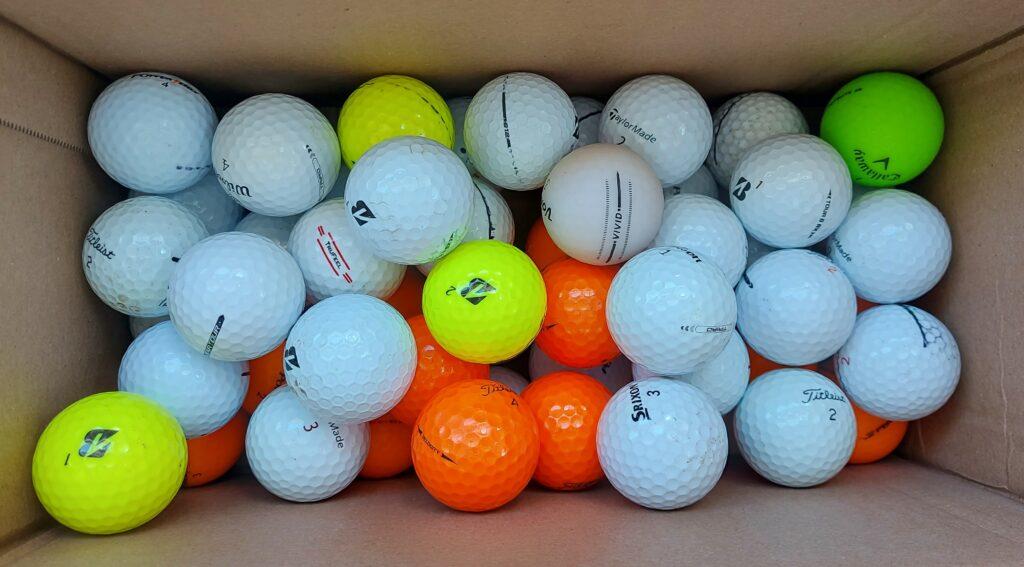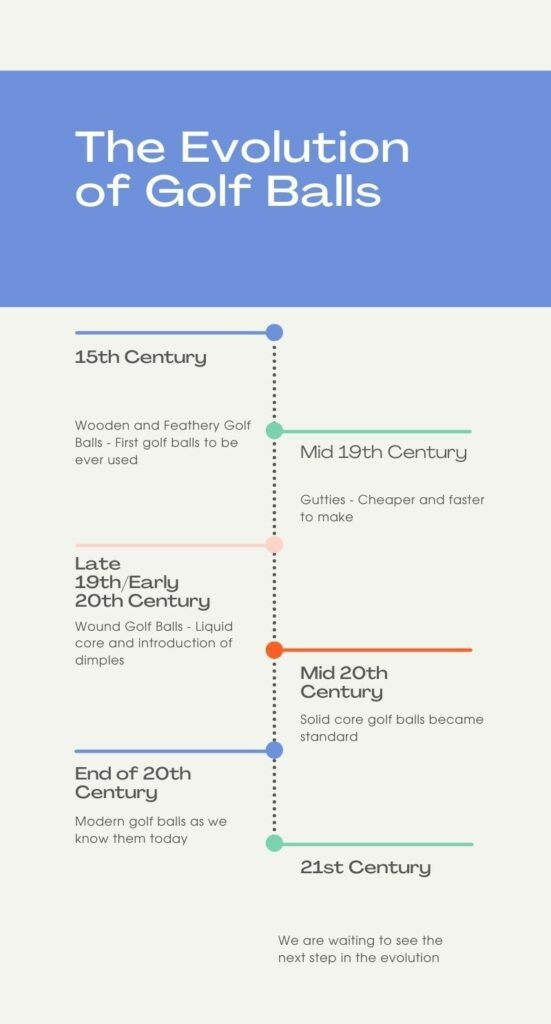I sometimes ask myself, who makes the best golf balls, is it Titleist, is it TaylorMade, is it Callaway, is it Srixon, is it Bridgestone, or is it any other brand, but the answer is not that simple. I have personally tried only a few different golf balls, being fairly new to golf, and I’m still looking for my favorite ball.
A whole study could be made around trying to answer who makes the best golf balls. I will try to scratch the surface of the topic by covering some areas based on the golf ball market and the professional players’ choices, as well as golf ball history and facts.

Who Makes the Best Golf Balls? – The Winner Is…
Every year there are lists made on the subject of the best golf ball, and numerous tests and reviews are done, but is there a clear winner? If we have a look at the tests and review results, the golf balls’ performance is similar across all the tested areas, from distance and ball speed to spin rate and feel.
If we have a look at the professional players’ preferences, we can see Titleist golf balls are the choice of a lot of players, followed by TaylorMade, Callaway, Bridgestone, and Srixon. Does that mean Titleist makes the best golf balls? Maybe they do, maybe they don’t. The golf balls’ playfield seems to be more level than ever. At the end of the day, I believe it is more a matter of personal preference, and whichever ball works the best for you is going to be the best-made one.
The Evolution of Golf Balls
According to available data, golf balls date to the 15th century when the game of golf originated in Scotland. There are theories that wooden balls were used at the very beginning of the golf era. However, different sources tell different stories. By the end of the century, feathery balls came into use. Those were round leather pouches stuffed with goose or chicken feathers, hand-sewn and coated with paint.
You can only imagine how it was to hit a wooden or feathery ball with a wooden stick. It wasn’t pleasant for sure.
Next, this ball dates to the middle of the 19th century. Those were made from dried sap of the Malaysian sapodilla tree. These balls were called gutties, and were cheaper and faster to make.
The end of the 19th and beginning of the 20th century saw a breakthrough in golf ball technology. The wound golf ball was born.

According to sources it consisted of a liquid-filler or solid round core that was wound with a layer of rubber thread into a larger round inner core and then covered with a thin outer shell made of balata sap. Manufacturers introduced dimples into the ball design during the same period.
Due to the danger of the liquids used in manufacturing, in the 1920s manufacturers stopped using liquid cores. Finally, in the 1960s solid-core golf balls became standard.
The New Era
Today the manufacturers keep the material composition used to make golf balls a secret. The only thing we know is there are single-piece, two-piece, three-piece, four-piece, and five-piece golf balls. Beginners and amateur golfers mostly use two-piece balls. While more skilled players and professional golfers use multi-layered balls. One-piece golf balls are a rarity, only used on driving ranges. All the golf ball manufacturers claim their golf balls are the best, but who does make the best golf balls?

The Big Names
There are numerous companies making golf balls, these are the 3 big ones that hold the majority of the market:
Titleist
Founded in 1932, the company focuses on golf balls and clubs. Usually the top-selling golf ball brand, they established themselves as the industry leader. It is the most used gold ball among top professional golfers and is certainly used among numerous amateur golfers. They offer a wide range of golf balls from premium to recreational, and their flagship balls are the Titleist Pro V1 and the Titleist Pro V1x.
Check out all my Titleist golf balls reviews.
TaylorMade
Founded in 1979, the company focuses on golf balls, clubs, and clothing. One of the top sellers, they also have a wide range of golf balls. Their flagship balls are the TaylorMade TP5 and TaylorMade TP5x.
Check out all my TaylorMade golf balls reviews.
Callaway
Founded in 1982, the company focuses on golf balls, clubs, and clothing. The youngest of the top 3 companies offers a wide range of golf balls. Their flagship golf balls are the Callaway Chrome Soft and Callaway Chrome Soft X.
Check out all my Callaway golf balls reviews.
The Contenders
Besides the three biggest companies that make golf balls, several contenders are getting better and better every year. Being in a very competitive market, they have to work hard to keep up with the industry leaders. Some of these brands are at least in the same category as the biggest ones when it comes to golf ball quality. The ones standing out are Bridgestone and Srixon.
Bridgestone
Founded in 1931, the company focuses on golf balls and clubs. It has a long history of making golf balls, and it started making clubs just in the 1970s’. The flagship golf balls are the Bridgestone Tour B X, Bridgestone Tour B XS, Bridgestone Tour B RX, and Bridgestone Tour B RXS.
Check out all my Bridgestone golf balls reviews.
Srixon
Founded in 1996 as a subsidiary of SRI (founded in 1909), the company focuses on golf balls and clubs. The flagship golf balls are the Srixon Z-STAR and Srixon Z-STAR XV.
Check out all my Srixon golf balls reviews.
The Best of the Rest
Mizuno
Founded in 1906, the company focuses on sports equipment and sportswear. The flagship golf balls are Mizuno Pro X and Mizuno Pro S.
Snell
Founded in 2015, the company focuses on golf balls, accessories, and apparel.
Snell balls family: Snell Prime 2.0, Snell PRIME 3.0, Snell PRIME 4.0, and Snell GET SUM.
Vice
Founded in 2013, the company focuses on golf balls, accessories, and apparel.
Vice balls family: Vice PRO PLUS, Vice PRO, Vice PRO AIR, Vice TOUR, and Vice Drive.
Check out all my Vice golf balls reviews.
Volvik
Founded in 1980, the company focuses on golf balls and equipment. The flagship golf balls are Volvik Condor and Volvik Condor X.
Wilson
Founded in 1913, the company focuses on sports equipment. The flagship golf balls are the Wilson Staff Model and Wilson Staff Model X.
Check out all my Wilson golf balls reviews.

What Makes the Golf Ball Good?
Is it the feel? Distance? Spin? Marketing? Is it the combination of all together? It is not an easy question to answer. There certainly are different categories of golf balls, and all the characteristics define the quality of a golf ball.
Firstly, golf balls are built differently. Premium golf balls are made of 3, 4, or 5 pieces. They have a softer feel, they are durable, and they usually have a high spin rate, but can also go long distances when hit with a driver. Skilled players and professionals can benefit from these balls. Premium golf balls offer the best performance, and for that reason, they are the most expensive ones.
There are two more categories. One is the two-piece which covers a huge range of golfers. The other one is non-tour three-piece golf balls. Both can be softer or harder, they are usually durable due to the harder outer cover construction. They are made for distance or feel, have a lower spin rate, and in most cases are used by average players or beginners. Thus, they tend to be more affordable, and there are a lot of these types of balls on the market. Most companies that make golf balls offer all three categories. Therefore, there are plenty of balls to choose from on the market.
Which is your favorite golf ball brand? Share below!
Related:
- How Are Modern Golf Balls Made – The Technology Behind
- What Golf Ball Should I Play? – Guide for Better Golfing


Hello, your insightful exploration of golf ball evolution and the prominent brands in the market offers a comprehensive overview for both beginners and enthusiasts. The historical journey from wooden and feathery balls to modern, multi-layered compositions is well-documented. Your guide effectively introduces major players like Titleist, TaylorMade, and Callaway, providing details on their flagship products and professional endorsements. The inclusion of rising contenders like Bridgestone and Srixon adds depth to the analysis.You wisely emphasize the subjective nature of determining the “best” golf ball, highlighting personal preference as the ultimate decider. Overall, a well-researched and engaging read for those navigating the diverse world of golf balls. Well done.
Hi Ela,
Thank you for your comment. I believe it is good to know where golf balls come from to have a better understanding of the modern ones. There is always going to be a personal preference at the end of the day. However, from a technical point and an overall preference, Titleist is number one.
Hi Dan,
“Who makes the best golf balls” is a nuanced and highly subjective discussion that touches on various aspects such as technology, brand heritage, and player preference. Exploring this topic, considering factors like the evolution of golf balls, the secretive material compositions used by manufacturers, and the endorsements from professional players, opens up a broader conversation about how personal and technical preferences influence our choices in sports equipment. It’s fascinating to see how brands like Titleist, TaylorMade, and Callaway are highlighted alongside contenders like Bridgestone and Srixon, illustrating the competitive yet diverse nature of the market. This discussion underscores the quest for the “best” golf ball and the importance of finding the right ball that suits an individual’s play style and needs.
Hi Sara,
Thank you for your comment. Golf balls never stopped evolving, since the very beginning. Even now we are on the verge of another evolution. With the new regulations implied by the governing bodies there is going to be a rollback on how far the balls are allowed to go. This gives a chance to all the brands to catch up with Titleist, who is by far the most popular golf ball brand. Nevertheless, I believe it is going to remain a personal preference to choose who makes the best golf balls.